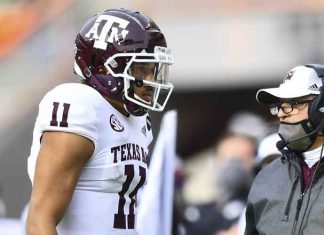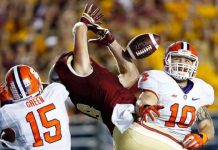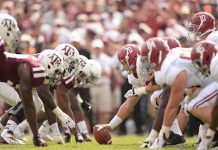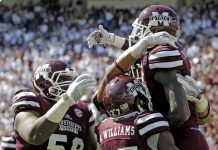Welcome back, UAB.
Now, the real work begins.
For the Blazers, and so many other programs on the fringes of supposedly major-college football, it’s hard to envision a scenario where this all works out in the long run. There’s a dark cloud that still looms somewhere off in the distance, a tab that will come due – and some schools, inevitably, won’t be able to pay up.
In Birmingham, at least, those are issues for another day.
This is a time of celebration, sort of like the honeymoon for a second marriage. The Blazers were extinguished after the 2014 season, a seemingly rash decision that set off a firestorm of protest. A few months later, the UAB administration reversed course and announced the program would be restored, thanks for a massive fundraising effort.
The second chapter of this feel-good story becomes a reality on Saturday, when the Blazers host Alabama A&M at Legion Field.
”It’s not going to be the same as before,” linebacker Shaq Jones, one of the few players from the old program to stick around for the rebirth, wrote on The Players’ Tribune. ”I still miss my old teammates and the way things were. But after everything that’s happened, I think the feeling of stepping foot on that field once again in a UAB jersey is going to make it all worth it.”
The immediate gratification is touching.
The long-term prognosis is far more of a crapshoot.
”What I don’t want us to lose is how important this is for our school and our community,” said coach Bill Clark, who also stayed on board for the rebuild. ”Hopefully our community feels that sense of, `We need you, we need you week three and every week after that.”’
That sentiment is important.
To its credit, UAB raised the funds for a fancy new football practice facility. But the Blazers are still playing games several miles from campus at decrepit Legion Field, greatly reducing the chance of sustainable success. There is talk of building a new downtown stadium that would host the Blazers and other events, but the tricky details of how to pay for it have yet to be worked out.
You see, there are big-time programs, schools such as Alabama and Florida State, which will meet Saturday night at Atlanta’s new Mercedes-Benz Stadium before a sellout crowd of more than 70,000 and a national television audience.
Then there are programs that cost big time, a list that kept growing as more and more schools rushed to launch Football Bowl Subdivision teams or make the jump from a lower level that, in all honesty, is probably far more suitable.
Most have learned the hard way that it’s not exactly like printing money.
Take Georgia State, a school in downtown Atlanta once devoted entirely to commuters. In its push to become more of a mainstream campus, which has led to the construction of several towering dorms housing thousands of students, a football program was launched in 2010. More than 30,000 turned out at the Georgia Dome for the historic first game.
It remains the largest crowd in the history of the program.
Only five times since then have the Panthers drawn as many as 20,000 fans to a home game. The massive Georgia Dome became their mausoleum, with announced crowds that looked bad on paper and, even then, were clearly padded to keep from being downright embarrassing.
Then again, it was easy to see why turnouts essentially boiled down to family and friends.
The product on the field has been just as bad.
Now in its eighth season, Georgia State has posted a cumulative record of 20-63, which includes a stretch where they lost 34 of 36 games. The Panthers are now on their fourth head coach, Shawn Elliott, and it became apparent just how much work remains to be done when his first game ended with a 17-10 loss to FCS school Tennessee State on Thursday night.
”A very, very poor performance,” moaned Elliott, echoing the assessment of so many games before he arrived.
Georgia State actually caught a huge break, taking over Turner Field when the Atlanta Braves decided to move to a new stadium in the suburbs. After a hasty remodeling job that converted the 50,000-seat ballpark into a 24,000-seat football facility (not counting the closed-off upper deck), the Panthers finally had a home to call their own, just a mile from the center of campus and the proposed anchor of a massive redevelopment that will add even more dorms, athletic facilities and classroom space.
Then, amid all the giddiness, Georgia State went out and played a terrible game in front of a near-sellout crowd.
Hard to imagine many of those fans coming out for the next game.
”Hopefully,” center Gabe Mobley said, ”they’ll give us another chance.”
For so many of these programs – and with UAB’s return, there are now 131 schools playing in or moving up to the Football Bowl Subdivision – hope is about the only thing they’ve got going.
Unfortunately, that doesn’t pay the bills for a sport that is far most costly than any other team on campus. Just imagine what will happen if that small slice of television revenues, largely hoarded by the Power Five schools, begins to trickle away as so many are predicting.
Yes, it’s only natural to cheer on the Blazers as they return to the field.
But let’s not forget that it’s hard work to start a football program.
It’s even tougher to make it work.
—
Paul Newberry is a sports columnist for The Associated Press. Write to him at pnewberry(at)ap.org or at www.twitter.com/pnewberry1963 . His work can be found at https://apnews.com/search/paul%20newberry
—
For more AP college football: http://collegefootball.ap.org and https://twitter.com/AP-Top25
25% Bonus via Western Union

















